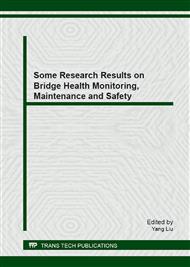p.79
p.87
p.99
p.107
p.119
p.131
p.141
p.153
p.165
Impact Analysis of the Flexural Rigidity on the Frequency and Tension of the Stay Cable
Abstract:
Research and practice show that frequency method is still the most practical and accurate method among all kinds of cable force measurements. Based on the classical string vibration theory, the finite element model of stay cable was created, and a method of iteratively computing stay cable balance curve considering with flexural rigidity was proposed. How dose the flexural rigidity affects the balance curve of stay cable was discussed, and the changing curves of the distance-to-sagging ratio following the pull-to-bend ratio were plotted, which indicated the bigger flexural rigidity, the smaller sagging. 25 pairs cable modality of Xichang cable stayed bridge were accurately analyzed, mode crossover was testified by finite element method, changing curves of frequency and mode shape following the cable force were separately plotted, and changing rule was induced, practical cable force computing method was given. Frequency difference is suitable to judge the rank of actual measurement frequency, and the second frequency is recommended to compute cable force. Engineering instance analysis testified, the method of practical cable force measurement could rule out errors by mode crossover, and be applied to cable with any lengths and any force.
Info:
Periodical:
Pages:
153-163
Citation:
Online since:
January 2013
Authors:
Price:
Сopyright:
© 2013 Trans Tech Publications Ltd. All Rights Reserved
Share:
Citation:


